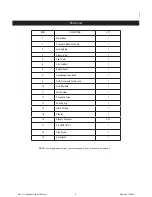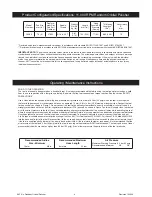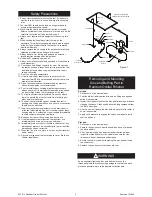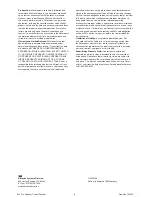
3M 3 in. Random Orbital Polisher
1
Revision 102309
3M 3 in. Random Orbital Polisher
1
Revision 102309
3M 3 in. Random Orbital Polisher
2
Revision 102309
Parts Page
CAUTION!
To reduce the risks associated with skin abrasion, burns, cuts, or entrapment:
• Keep hands, hair, and clothing away from the rotating part of the tool.
• Wear suitable protective gloves while operating tool.
• Do not touch the rotating parts during operation for any reason.
• Do not force tool or use excessive force when using tool.
To reduce the risks associated with whipping or hazardous pressure-rupture:
• Ensure supply hose is oil resistant and is properly rated for required working pressure.
• Do not use tools with loose or damaged air hoses or fittings.
• Be aware that incorrectly installed hoses and fittings might unexpectedly come loose at any time and create a whipping/impact
hazard.
To reduce the risks associated with fly off of abrasive product or parts:
• Use care in attaching buff pad and disc pad; following the instructions to ensure that they are securely attached to the tool before
use.
• Never free spin the tool or otherwise allow it to be started unintentionally.
• Never point this product in the direction of yourself or another person, or start tool unintentionally.
• Never over-tighten accessory fasteners.
To reduce the risks associated with vibration:
• If any physical hand/wrist discomfort is experienced, work should be stopped promptly to seek medical attention. Hand, wrist and
arm injury may result from repetitive work, motion and overexposure to vibration.
To reduce the risks associated with loud noise:
• Always wear hearing protection while operating this tool. Follow your employer’s safety policy or local/national standards for
personal protective equipment requirements.
To reduce the risks associated with fire or explosion:
• Do not operate the tool in explosive atmospheres, such as in the presence of flammable liquids, gases, or dust. The abrasives are
able to create sparks when working material, resulting in the ignition of the flammable dust or fumes.
• Refer to MSDS of material being worked as to potential for creating fire or explosion hazard.
To reduce the risks associated with hazardous dust ingestion or eye/skin exposure:
• Use appropriate respiratory and skin protection, or local exhaust as stated in the MSDS of the material being worked on.
To reduce the risks associated with hazardous voltage:
• Do not allow this tool to come into contact with electrical power sources as the tool is not insulated against electrical shock.
























